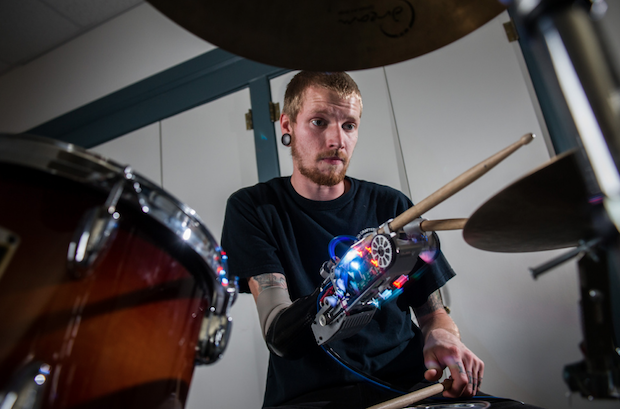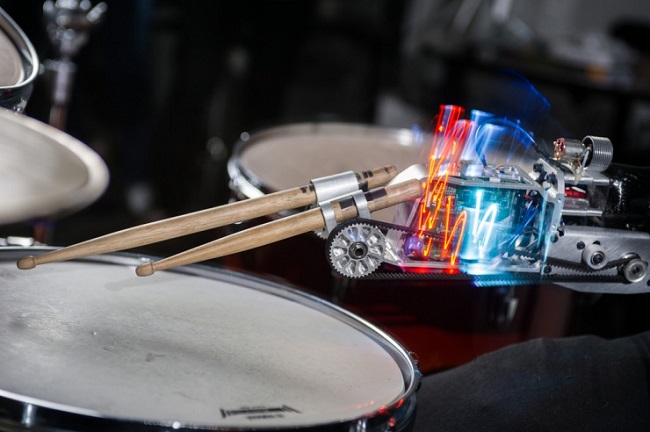Jason Barnes is ordinary human drummer who lost his right arm below the elbow after being electrocuted, but thanks to Georgia Tech professor Gil Weinberg, Barnes has a new bionic arm that not only restored his ability to play music, but made him into a drumming equivalent of a three-armed cyborg.

Professor Weinberg is an expert at designing robots that play music, having assembled a band that includes a robot drummer that can detect beats played by a human, as well as a robotic marimba player that can improvise melodies. Drawing from this knowledge, he created an attachable prosthesis with motors powering two drumsticks; one stick is controlled directly by the Barnes’ arm using electromyography (EMG) muscle sensors, while the second stick crafts its own beat based on what it “hears.”

“The second drumstick has a mind of its own,” said Weinberg, “The drummer essentially becomes a cyborg. It’s interesting to see him playing and improvising with part of his arm that he doesn’t totally control.”
Soon after Barnes’ wound healed, the percussionist devised his own prosthetic to help continue playing, but his design could not account for the speed and bounce controlled by a human wrist and fingers. Professor Weinberg’s design remedies this by allow Barnes’ to control his prosthetic through the contractions in his biceps, which signals to the embedded chip how much to tighten or loosen the sick in order to control the rebound. If Barnes’ wants complete control over his playing, he only need remove stick from the automated motor, although Professor Weinberg thinks that leaving this stick to respond to what it hears may yield surprising and inspiring results.
The prosthesis has given Barnes certain playing abilities he never had before, moving the sticks faster than humanly possible. The motors can also be programmed to play the sticks at different rhythms, furthering enhancing the illusion of Barnes having three arms.
“Music is very time sensitive. You can hear the difference between two strokes, even if they are a few milliseconds apart,” adds Weinberg. “If we are able to use machine learning from Jason’s muscles (and in future steps, from his brain activity) to determine when he intends to drum and have the stick hit at that moment, both arms can be synchronized.” This type of robotic synchronization coupled anticipation algorithms is the first crucial step in developing the technology necessary for controlling embedded, mechanical limbs to aid complex, physical operations as endured by surgeons and astronauts.
Barnes is just happy he can not only play music again, but play it fast enough to make even the most accomplished metal drummers jealous. He will for the first time publically demonstrate his arm at the March 22nd Robotic Musicianship Demonstration and Concert Kennesaw State University’s Bailey Performance Center.
Story via IEEE Spectrum and Georgia Tech
Advertisement
Learn more about Electronic Products Magazine





